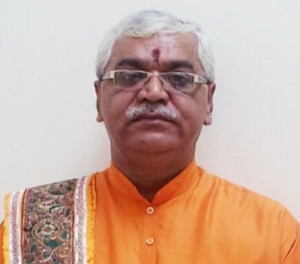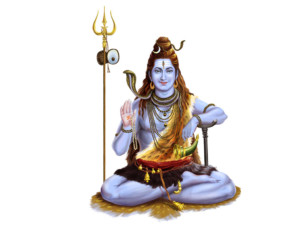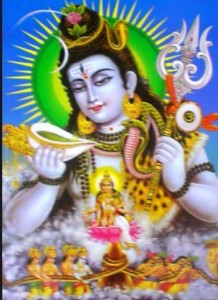
Every year, Maha Shivaratri is celebrated by Hindus all over the world and millions of devotees visit various temples of Lord Shiva throughout the day and until mid-night to have his Divya Darshan in the most sacred and powerful Sheela Moorti- Shiva Lingam form.
In every lunar-solar month of the Hindu calendar, there is a Shivaratri on the 13th night and 14th day of the new moon that is during the dark half of the month. But there are two Shivaratris that are generally observed with great reverence: 1) Shravan Shivaratri, which falls usually between July and August or in the Shravan Masa of Hindu calendar. This Masa is a special month dedicated to worshipping Lord Shiva and Mangal Gauri for their revered blessings. 2) Phalguna Shivaratri is called Maha Shivaratri because Lord Shiva emerged in his Nirguna Rupa that is Shiva Lingam.
Maha Shivaratri is the most holy of the twelve Shivaratris and comes in late winter – either in February or March– and before Spring arrives. On this night, the position of planet in northern hemisphere is very conducive to the natural upsurge of energy in human beings as well.
The reason behind this festival marks the overcoming of darkness and ignorance in life and in the world by remembering Shiva through fasting, changing his prayers, considering to follow good morals, values, virtues of honesty, discipline, kindness and forgiveness. We can also take an oath to restart our life on a virtuous path. Three main events in Shiva’s life are celebrated on this day.
Firstly, Shivaratri is the day when the absolute formless God Sadashiv appeared in the form of Lingodbhav Moorti exactly at midnight. Secondly, Shivaratri is also the ceremonious wedding anniversary when Lord Shiva was married to Devi Parvati. Thirdly, Shivaratri is also a day of thanksgiving to Lord Shiva for protecting us from annihilation. On this day, it is believed that Lord Shiva became Neelkanth (the blue-throated one), by swallowing the deadly poison that arose during the Samudra Manthan of Kshir Saagar (churning the milky ocean) by gods and demons.
That is the reason, every living creature on this earth owes thanks to Lord Shiva for saving this beautiful life and universe for us. Shiva Ling represents Lord Neelkanth as he appears in this form on this day and devotees offer jal with utmost devotion to quench Agni (heat) of the poison in him.
Another reason for his blue neck is holding words Ra and Ma in his throat. It is said that Lord Shiva wrote Ramayana with 1 lakh Shlokas as he considers Lord Rama as his Guru. There was a fight to divide these Shlokas among the trinity. After all the divisions two letters Ra and Ma remained which he kept them in his throat.
Lord Shiva says that he is a Sevak (servant) of Lord Ram in his Hanuman form. Lord Shiva is considered as Lord Rama’s Swami (Master) when Lord Rama worshipped Lord Shiva in the form of Rameshwara Lingam. Lord Shiva is a symbol of trust and he grants his devotees wishes. So, Lord Ram worshipped him for his success before starting war with Ravan. Lord Shiva said in his appreciation that Lord Rama is his Sakha (friend). Lord Rama said if my devotees make difference between us, they will go to hell. Maha Shivaratri is also remembered as the night when Shiva performed the heavenly dance of creation, preservation, and destruction.
 To show our gratitude and thankfulness to Lord Shiva, perform holy rituals and offer devotional prayers with jal, milk, yogurt, sugarcane juice, Bilvapatra/leaves, dhatura, white flowers, fruits, and sweets to Shiva Lingam and chant the sacred Panchakshara Mantra, Om Namah Shivaya, which translates to “salutations to Shiva” for at least 108 times.
To show our gratitude and thankfulness to Lord Shiva, perform holy rituals and offer devotional prayers with jal, milk, yogurt, sugarcane juice, Bilvapatra/leaves, dhatura, white flowers, fruits, and sweets to Shiva Lingam and chant the sacred Panchakshara Mantra, Om Namah Shivaya, which translates to “salutations to Shiva” for at least 108 times.
If possible, participate in puja, devotional music and dance performances by children arranged in the temples until the mid-night to remember Lord Shiva’s brave actions and in an awaken state to see his glorious appearance in the Shiva Lingam form.
Festival of Maha Shivaratri has tremendous significance in Hinduism. Hindu mythology says that a devotee who performs sincere worship of Lord Shiva on the auspicious day of Shivaratri is cleared of his past and present lives’ sins, also liberated from the cycle of birth and death and attains moksha at last.
Lord Shiva is a symbol of trust for his devotees because he grants his devotees’ all wishes and removes their sins when they pray for his blessings with utmost dedication and passion. That is why Lord Shiva is called Bholenath. Married women observe fasting and perform Shiva Puja and pray for their husbands’ well-being, and also appease Goddess Parvati/Gauri – one who bestows marital bliss, long and prosperous married life.
Parvati is symbol of devotion and through her devotion she won the trust of Lord Shiva. People also believe that flowers bloom exactly the day after Maha Shivaratri, hinting at the fertility of earth. Fasting is an important activity on Maha Shivaratri day as it detoxifies the body and purifies the
Pt Anil Joshi







